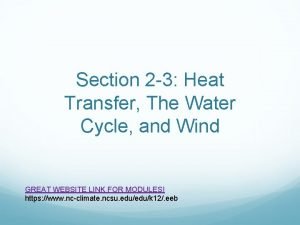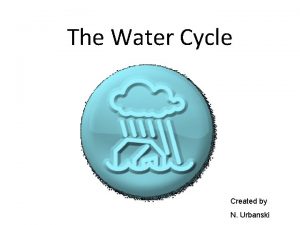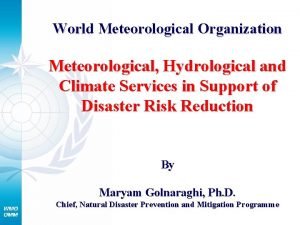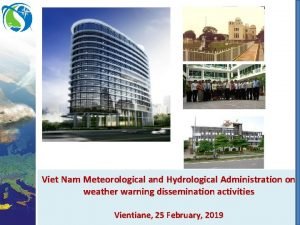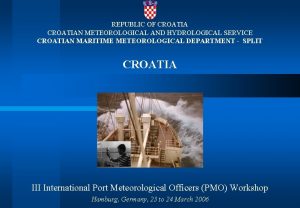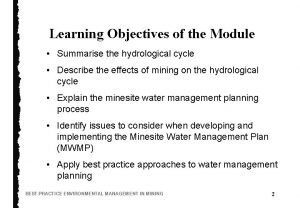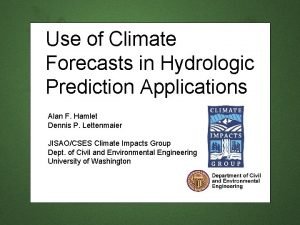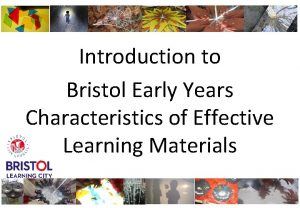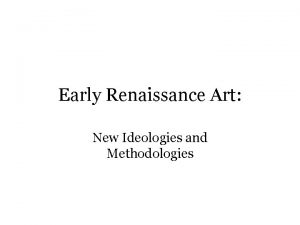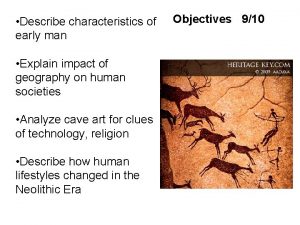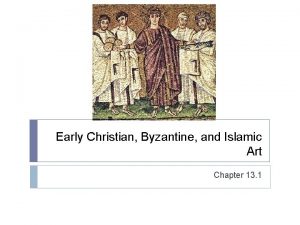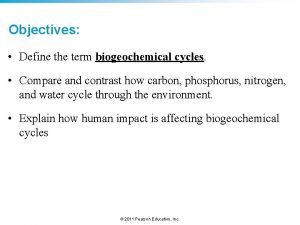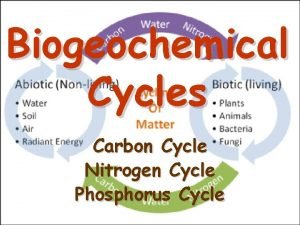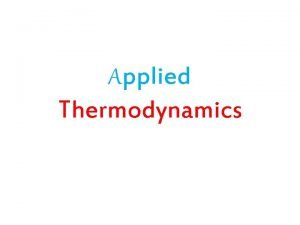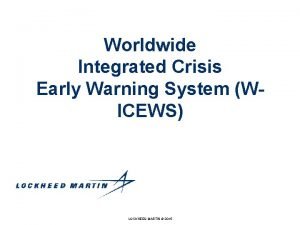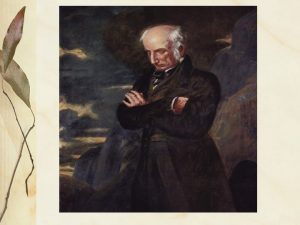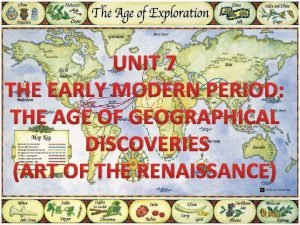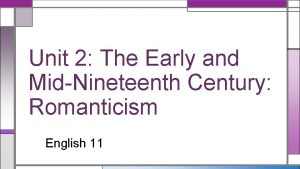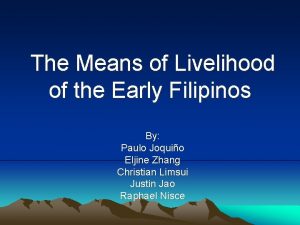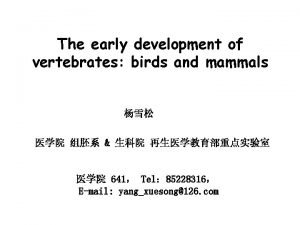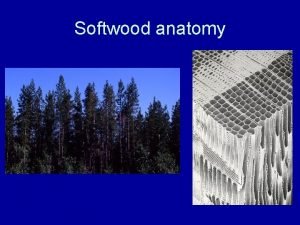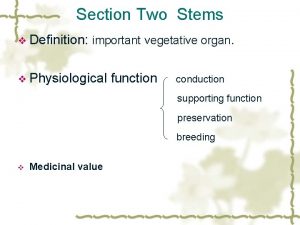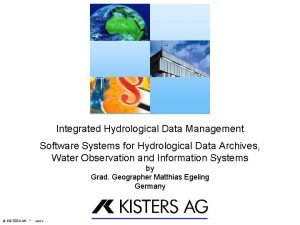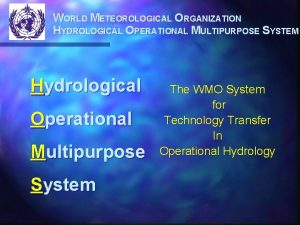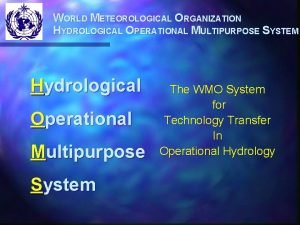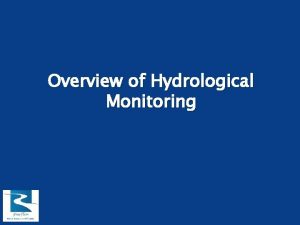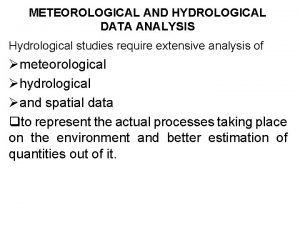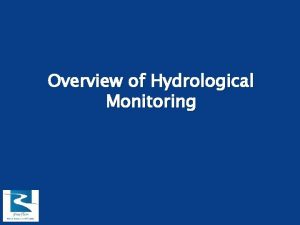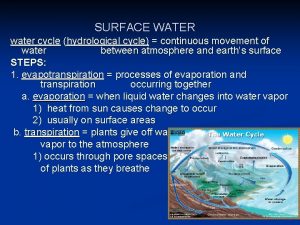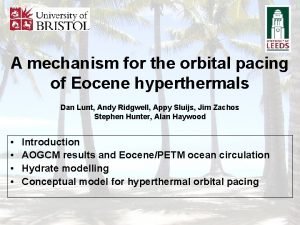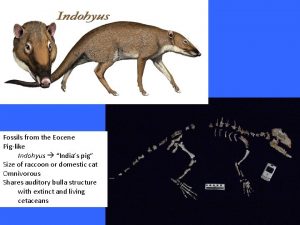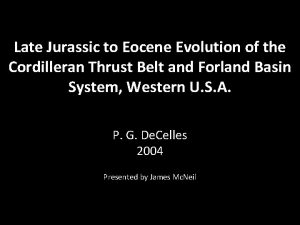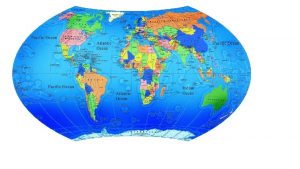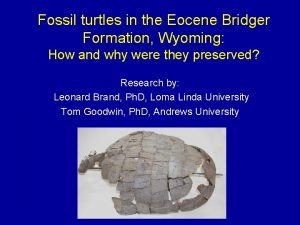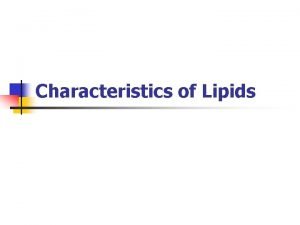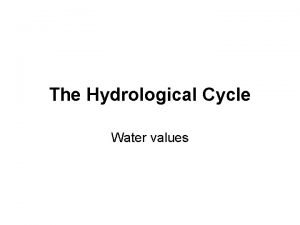Constraining Hydrological Cycle Characteristics of Early Eocene Hyperthermals






























































- Slides: 62

Constraining Hydrological Cycle Characteristics of Early Eocene Hyperthermals Srinath Krishnan

Reasons for study Rainfall has direct impact on human society Impact of anthropogenic activity on rainfall patterns is not well understood Modern studies suggest intensification of hydrological cycle with warming Wet Dry Wetter Dryer Lack of data inhibits validation of these models in a complex natural system

Reasons for study Rainfall has direct impact on human society Impact of anthropogenic activity on rainfall patterns is not well understood Modern studies suggest intensification of hydrological cycle with warming Wet Dry Wetter Dryer Lack of data inhibits validation of these models in a complex natural system

Reasons for study Rainfall has direct impact on human society Impact of anthropogenic activity on rainfall patterns is not well understood Modern studies suggest intensification of hydrological cycle with warming Wet Dry Wetter Dryer Lack of data inhibits validation of these models in a complex natural system

Reasons for study Rainfall has direct impact on human society Impact of anthropogenic activity on rainfall patterns is not well understood Modern studies suggest intensification of hydrological cycle with warming Wet Dry Wetter Dryer Lack of data inhibits validation of these models in a complex natural system

Early Eocene Hyperthermals Paleocene-Eocene Thermal Maximum • • ~3 -50 C rise in temperature Negative carbon isotope excursion of 2. 5 -6‰ Eocene Thermal Maximum 2 • • Adapted from Zachos et al. (2001) Smaller rise in temperature compared to the PETM set on a warming trend Carbon isotopic excursion about half of the PETM

Early Eocene Hyperthermals Causes Methane Hydrates (Dickens et al. , 1995) Burning of terrestrial organic matter (Kurtz et al. , 2003) Estimates of greenhouse gas concentrations Pre-PETM: ~600 – 2, 800 ppm of CO 2 PETM: ~750 – 26, 000 ppm of CO 2 ~1, 500 – 55, 000 Gt C in the atmosphere ~3, 900 – 57, 000 Gt C released in the oceans Modern atmospheric CO 2 concentration: ~360 ppm Modern Conventional fossil fuel reserves: ~5, 000 Gt C

Early Eocene Hyperthermals Causes Methane Hydrates (Dickens et al. , 1995) Burning of terrestrial organic matter (Kurtz et al. , 2003) Estimates of greenhouse gas concentrations Pre-PETM: ~600 – 2, 800 ppm of CO 2 PETM: ~750 – 26, 000 ppm of CO 2 ~1, 500 – 55, 000 Gt C in the atmosphere ~3, 900 – 57, 000 Gt C released in the oceans Modern atmospheric CO 2 concentration: ~360 ppm Modern Conventional fossil fuel reserves: ~5, 000 Gt C

GOAL Use early Eocene hyperthermals as analogues to study changes in the hydrological cycle during extreme warming events

Schematic of a Water Cycle Adapted from NASA Goddard Flight Center

Expected changes with warming Increased lower tropospheric water vapor Dr. Raymond Schmitt: http: //www. whoi. edu/sbl/lite. Site. do? litesiteid=18912&article. Id=28329 In the extra-tropics, the important components of the hydrological cycle that affect isotopic signals are Horizontal poleward flow of moisture Changes in precipitation and evaporation

Variations in Precipitation with warming 2. 80 c in 2100 Increased Evaporation Held and Soden (2006)

Variations in Precipitation with warming 2. 80 c in 2100 Increased Precipitation Held and Soden (2006)

Isotopes and Precipitation

Modern annual precipitation http: //www. waterisotopes. org

Rayleigh Distillation Clark and Fritz, 1997

Rayleigh Distillation Increased depletion with progressive rainout events Clark and Fritz, 1997

Hypotheses There is a systematic change in moisture transport to the higher latitudes during warming events Are there similar changes in δD between the two hyperthermals at the higher latitudes? Can these changes be detected on a global scale? Can this theoretical model be reproduced with an isotope coupled climate model?

Proxies n-alkanes: Single chain hydrocarbon with long chain lengths (n-C 23 -35) indicating terrestrial plant/leaf wax sources Compound-specific hydrogen isotopic composition represents meteoric water modified by evapotranspiration Compound-specific carbon isotopic compositions represents environmental and ecological conditions

Proxies n-alkanes: Single chain hydrocarbon with long chain lengths (n-C 23 -35) indicating terrestrial plant/leaf wax sources Compound-specific hydrogen isotopic composition represents meteoric water modified by evapotranspiration Compound-specific carbon isotopic composition represents environmental and ecological conditions

n-alkanes and precipitation Deuterium nalkanes Adapted from Sachse et al. , 2006)

Biomarker transport Continent Oceans Aerosols (with waxes) Wind Terrestrial Plants Rivers Adapted from Eglinton and Eglinton, 2008

Methods Samples Crushing and Extraction Total Lipid Extract Compound Separation n-alkane and biomarker fractions Gas Chromatogram Analyses Clean-up Procedures Compound Detection & Identification Compound-specific Isotope Ratio Mass Spectrometer Compound-specific Deuterium & Carbon isotope compositions Analytical Uncertainty: ± 5‰

IODP-302 Arctic Coring Expedition

Arctic Paleocene-Eocene Thermal Maximum ~55. 6 Ma Duration: ~150 -200 kyrs Modified from Pagani et al. , 2006

Arctic Eocene Thermal Maximum-2 ~54 Ma Duration: ~75 -100 kyrs This work

Preliminary Conclusions Enrichment at the onset for both events with different magnitudes Decreased rainout for moisture reaching the poles 15 -20‰ magnitude depletions during the events Similar variations during both the events

Preliminary Conclusions Enrichment at the onset for both events with different magnitudes Decreased rainout for moisture reaching the poles 15 -20‰ magnitude depletions during the events Similar variations during both the events

Hypotheses There is a systematic change in moisture transport to the higher latitudes during hyperthermal events Are there similar changes in δD during the two hyperthermals at the higher latitudes? Preliminary Conclusion: Enrichments in δD do correspond with the hyperthermals at the onset of the event with similar magnitude depletions during the event Number of samples Arctic ETM-2: 29 samples

Hypotheses There is a systematic change in moisture transport to the higher latitudes during hyperthermal events Are there similar changes in δD during the two hyperthermals at the higher latitudes? Can these changes be detected on a global scale? Can this theoretical model be reproduced with an isotope coupled climate model?

Tropical PETM: Tanzania (Handley et al. , 2008)

Tropical PETM: Colombia (This work)

Mid-latitudes PETM: Bighorn Basin Smith et al. (2006)

PETM: High Latitudes Pagani et al. (2006)

Summary of changes during PETM Tropics Mid-latitudes Tanzania – 15‰ enrichment Colombia - ~30‰ depletion Lodo – No change during the event with hints of depletion at the onset and the end Bighorn Basin – No significant change Forada - ~10‰ enrichment at the onset followed by a 10‰ depletion during the event High Latitudes Arctic – 60‰ enrichment at the onset followed by 20‰ depletion through the event

Summary of changes during PETM Tropics Mid-latitudes Tanzania – 15‰ enrichment Columbia - ~30‰ depletion Lodo, California – No change during the event with hints of depletion at the onset and the end Bighorn Basin – No significant change Forada, Italy - ~10‰ enrichment at the onset followed by a 10‰ depletion during the event High Latitudes Arctic – 60‰ enrichment at the onset followed by 20‰ depletion through the event

Summary of changes during PETM Tropics Mid-latitudes Tanzania – 15‰ enrichment Columbia - ~30‰ depletion Lodo – No change during the event with hints of depletion at the onset and the end Bighorn Basin – No significant change Forada - ~10‰ enrichment at the onset followed by a 10‰ depletion during the event High Latitudes Arctic – 60‰ enrichment at the onset followed by 20‰ depletion through the event

Hypotheses There is a systematic change in moisture transport to the higher latitudes during hyperthermal events Can these changes be detected on a global scale? Preliminary Conclusion: Existing data not sufficient to draw conclusions about regional & hemispherical changes. Requires further studies on a global scale

Ongoing Work

Ongoing Work: Giraffe Core C 29

Ongoing Work: 1051 C 29

Ongoing Work: 1263 C 29

Ongoing Work: 690 C 29

Hypotheses There is a systematic change in moisture transport to the higher latitudes during hyperthermal events Are there similar changes in δD during the two hyperthermals at the higher latitudes? Can these changes be detected on a global scale? Can these changes predicted be reproduced with an isotope coupled climate model?

Future Work: Eocene Modeling Goal To utilize the global dataset developed to compare the hydrological response in terms of isotopes, temperatures and precipititation signals Simulations planned Hyperthemal scenarios (PETM vs. ETM 2) Different CO 2 concentrations Background Eocene

Thank You Acknowledgments Joint Oceanographic Institute, ODP/IODP Mark Pagani, Matt Huber, Appy Sluijs, Carlos Jaramillo Peter Douglas, Sitindra Dirganghi, Micheal Hren, Brett Tipple, Katie French, Keith Metzger, Courtney Warren, Matt Ramlow, Gerry Olack, Dominic Colosi Yale G&G Faculty, Staff & Students

Mid-latitudes PETM: Forada Tipple (unpublished)

Mid-latitudes PETM: Lodo Tipple (unpublished)

Paleogeography


C-3 Biosynthetic pathway

C-4 Biosynthetic pathway

Modern mean annual poleward flux

Changes in northward polar flux with doubling of CO 2 – IPCC AR-4 scenario Held & Soden, 2006

Proxies TEX-86 Derived from marine pico plankton Crenarchaeota Vary membrane fluidity and composition depending on the temperature Has recently been applied to analyze paleo. SST


Changes in GWML

Theoretical Model Warming results in increased lower tropospheric water vapor Scales according to the Clausius-Clayperon relationship In the extra-tropics, the important components of the hydrological cycle that affect isotopic signals are horizontal poleward flow of moisture and changes in precipitation and evaporation Simple models have been developed by scaling with the Clausius-Clayperon relation

Energy Use Phase

Energy generation Phase

FATTY ACID BIOSYNTHESIS PYRUVATE ACETOACETYL-ACP C O 2 ACETYL CO-A CO 2 MALONYL CO-A NAD PH BUTYRYL-ACP H 2 O 6 × MALONYL CO-A CO 2 PALMITATE (16: 0 FATTY ACID)

ISOPRENOID BIOSYNTHESIS NON-MVA-PAT MVA 2×ACETYL CO-A PATHWA Y PYRUVATE ACETOACETYL CO-A 3 -HYDROXY-3 -METHYL GLUTARATE 2 NADPH MEVALONATE DIPHOSPHATE CO 2 GLYCERALDEHYDE-3 P CO DEOXYXYLULOSE-P METHYL 2 ERYTHROSE-P NADPH METHYL ERYTHRITOL-P H 2 O ISOPENTENYL DIPHOSPHATE 2 NADPH
 Eocene oligocene miocene pliocene
Eocene oligocene miocene pliocene Love constraining to obedience
Love constraining to obedience Convection water cycle
Convection water cycle Hydrological cycle diagram
Hydrological cycle diagram National meteorological and hydrological services
National meteorological and hydrological services Vietnam meteorological and hydrological administration
Vietnam meteorological and hydrological administration Croatian meteorological and hydrological service
Croatian meteorological and hydrological service Hydrological
Hydrological Hydrological prediction center
Hydrological prediction center Early cpr and early defibrillation can: *
Early cpr and early defibrillation can: * Bristol early years
Bristol early years Characteristics of early renaissance art
Characteristics of early renaissance art Early christian art characteristics
Early christian art characteristics Early adulthood characteristics
Early adulthood characteristics Characteristics of philippine opera
Characteristics of philippine opera Characteristics of early man
Characteristics of early man Native american writing
Native american writing Byzantine and islamic art
Byzantine and islamic art Water cycle brain pop
Water cycle brain pop Quizlet
Quizlet Difference between phosphorus cycle and carbon cycle
Difference between phosphorus cycle and carbon cycle Difference between open cycle and closed cycle gas turbine
Difference between open cycle and closed cycle gas turbine Forbidden latency in computer architecture
Forbidden latency in computer architecture Chapter 5 principles of engine operation
Chapter 5 principles of engine operation Handball cycle 3
Handball cycle 3 What is the working fluid in closed cycle mhd system?
What is the working fluid in closed cycle mhd system? Cycle de consolidation
Cycle de consolidation Cycle 3 cycle de consolidation
Cycle 3 cycle de consolidation Water cycle the hydrologic cycle
Water cycle the hydrologic cycle Icews
Icews William wordsworth education
William wordsworth education Early years of william shakespeare
Early years of william shakespeare Random early drop
Random early drop Operating systems example
Operating systems example T-stem early college high school
T-stem early college high school Arti kale
Arti kale Valle verde early college high school calendar
Valle verde early college high school calendar Early modern period dates
Early modern period dates Post test the early and mid nineteenth century romanticism
Post test the early and mid nineteenth century romanticism Types of early childhood programs
Types of early childhood programs Types of early childhood programs chapter 2
Types of early childhood programs chapter 2 Teeth disking
Teeth disking Space coast early steps
Space coast early steps When things fall apart quotes
When things fall apart quotes If past perfect
If past perfect Livelihood of early filipino
Livelihood of early filipino Early years photography
Early years photography Cook
Cook Early middle ages
Early middle ages Early intervention transformation programme
Early intervention transformation programme Early development in birds
Early development in birds Elof standards 3k
Elof standards 3k Efq
Efq The dawn of the victorian age zanichelli
The dawn of the victorian age zanichelli Steve jobs timeline of life
Steve jobs timeline of life Quiz 1: the early missionary journeys
Quiz 1: the early missionary journeys Early wood and late wood
Early wood and late wood Shel silverstein early life
Shel silverstein early life Hgioelc examples
Hgioelc examples Aerial stem modification examples
Aerial stem modification examples What does prophase ii look like
What does prophase ii look like Summarise types of early years provision
Summarise types of early years provision Sandalwood bell schedule
Sandalwood bell schedule


